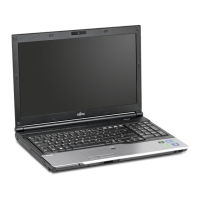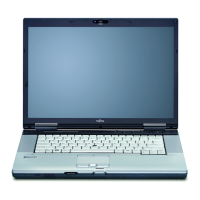Working with the notebook
LCD screen
LCDscreenNotes
High-quality LCD screens (T FT) are installed in Fujitsu notebooks. For technical reasons,
these screens are manufactured for a particular resolution. An optimum and sharp image can
only be ensured with the resolution intended for the particular screen. A screen resolution
which differs from the specification can result in an unclear image.
The resolution of your notebook’s screen is set to the optimum at the factory.
With the present sta ndards of production technology, absolutely flawless screen image s
cannot be guaranteed. There may be a few constantly light or dark pixels (picture
elements) on the screen. The maximum permitted number of such faulty pixels is
specified in the international standard ISO 9241-307 (Class II).
Example:
A screen with an HD re solution of 1366 x 768 has 1366 x 768 = 1049088 pixels. Each pixel consists
of three subpixels (red, green and blue), making a total of about 3 million subpixels. According to ISO
9241-307 (class II), a maximum of 2 light and 2 dark pixels and in addition 5 light or 10 dark subpixels
or an equivalent mix (1 light subpixel counts as 2 dark subpixels) are allowed to be defective.
Pixel
A pixel consists of 3
subpixels, normally red, green and
blue. A pixel is the
smallest element that can be generated
by complete functi
onality of the display.
Subpixel
A subpixel is a sep
arately addre ssable internal structure
within a pixel tha
t enhances the pixel function.
Cluster A cluster contains two or more defective pixels or
subpixels in a 5 x 5 pixel block.
Background li
ghting
LCD screens a
re operated with background lighting. The luminosity of the background
lighting can
decrease du ring the period of use of th e notebook. However, y ou
can s et the br
ightness of your scre en individually.
Synchroni
sing the display on the LCD s creen and an external monitor
For more in
formation, please refer to the chapter "
Key combinations", Page 24
under "Tog
gle output scree n ".
Fujitsu 29

